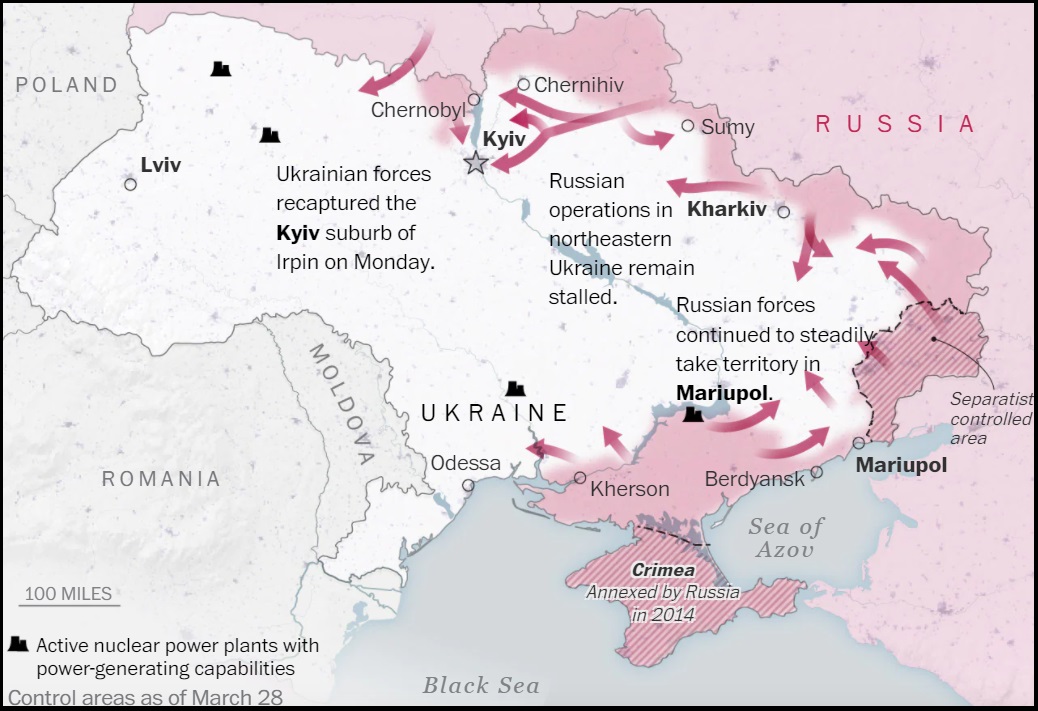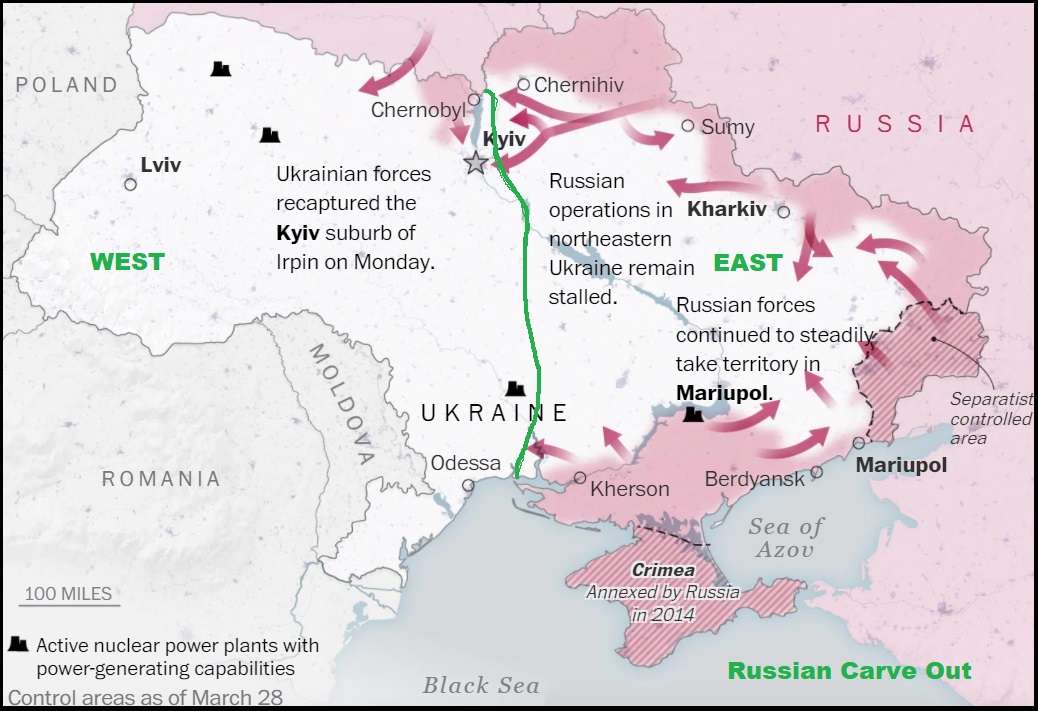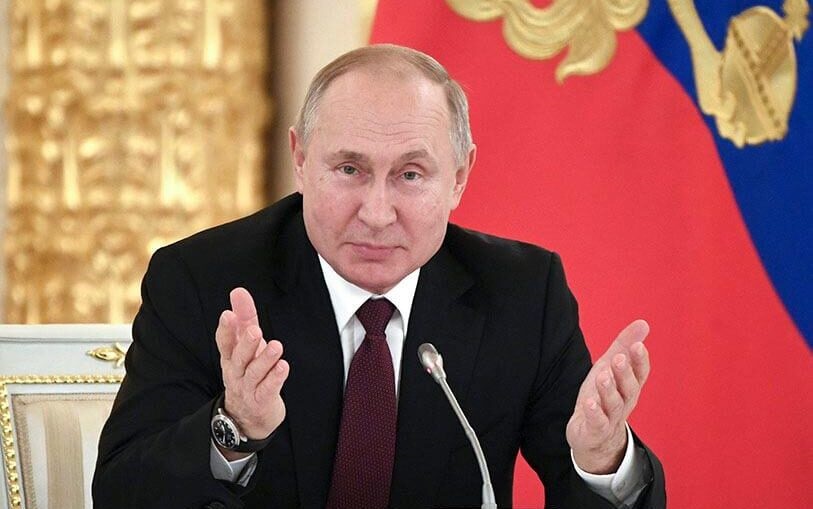While the western propaganda about the Russian objective in Ukraine remains at a fever pitch, most intellectually honest observers have always held that liberation of eastern Ukraine was the goal of Russia and western Ukraine was never part of the objective.
 With a decade-long civil war in eastern Ukraine preceding the current Russian operations, and with western forces supporting one side while Russia supported the other, it was always presumed -prior to the Russian military operations- that Vladimir Putin’s central goal was removing the NATO influence from eastern Ukraine.
With a decade-long civil war in eastern Ukraine preceding the current Russian operations, and with western forces supporting one side while Russia supported the other, it was always presumed -prior to the Russian military operations- that Vladimir Putin’s central goal was removing the NATO influence from eastern Ukraine.
That objective has seemingly remained visible throughout the conflict with Russian activity in western Ukraine limited in scope to targeting inbound NATO weapons and material support.
We might remember the 20-mile-long armored convoy that sat in place for weeks north of Kyiv while the media narrative was ‘any day now’. Those troops never moved on Kyiv, and in hindsight looked more like a strategic positioning of resources to keep western Ukraine in check while the more important goal of clearing eastern Ukraine was the ongoing operation.
It seems a little silly to point out the obvious, but everything Putin said about what he was doing in Ukraine is factually what has taken place. The western media narrative spinning his ‘true intents’ to be much more significant than his open statements, has never played out when reviewing the actual military operations. In short, Putin was then (as he said), and continues now, to be carving out eastern Ukraine and the Donbas region.
As the Russian operations in eastern Ukraine enter the clean-up and finalization stage, this report about the shift in Russian operations near Kyiv and western Ukraine makes a great deal of sense. The Reuters spin is that Putin was losing western Ukraine, ergo he is reducing activity. However, it never appeared that western Ukraine was part of the objective.
ISTANBUL/KYIV OUTSKIRTS/MARIUPOL, Ukraine, March 29 (Reuters) – Russia promised on Tuesday to scale down military operations around Ukraine’s capital and north, while Kyiv proposed adopting neutral status, in confidence-building steps that were the first signs of progress towards negotiating peace.
Their talks took place in an Istanbul palace more than a month into the largest attack on a European nation since World War Two. Russia’s invasion has been halted on most fronts by stiff resistance from Ukrainian forces who have recaptured territory even as civilians are trapped in besieged cities.
He made no mention of other areas that have seen heavy fighting, including around Mariupol in the southeast, Sumy and Kharkiv in the east and Kherson and Mykolaiv in the south.
Some analysts noted that Russia’s promise to reduce fighting mostly covered areas where it has been losing ground.
[…] Ukrainian negotiators said that under their proposals, Kyiv would agree not to join alliances or host bases of foreign troops, but would have security guaranteed in terms similar to “Article 5”, the collective defence clause of the transatlantic NATO military alliance.
They named Israel and NATO members Canada, Poland and Turkey as countries that may give such guarantees. Russia, the United States, Britain, Germany and Italy could also be involved.
The proposals, which would require a referendum in Ukraine, mentioned a 15-year consultation period on the status of Crimea, annexed by Russia in 2014. The fate of the southeastern Donbas region, which Russia demands Ukraine cede to separatists, would be discussed by the Ukrainian and Russian leaders.
Kyiv’s proposals also included one that Moscow would not oppose Ukraine joining the European Union, Russia’s lead negotiator Vladimir Medinsky said. Russia has previously opposed Ukrainian membership of the EU and especially of NATO. (read more)


On Tuesday, Russia’s Deputy Defense Minister Alexander Fomin held a press conference after Russia-Ukraine negotiations ended in Istanbul. In that conference, he read a statement that seemed to indicate that Russia is de facto accepting that its decapitation thrust launched at Kiev at the outbreak of hostilities has failed. (Note that the deputy defense minister made the statement, not Putin’s favorite courtier Sergei Shoigu, who hasn’t been seen in public since March 11, Russia’s Defense Minister Surfaces After Two Week. Disappearance and the Mystery Deepens.)
“Due to the fact that the talks on preparing an agreement on Ukraine’s neutrality and non-nuclear status as well as on providing Ukraine with security guarantees are moving to the practical sphere, considering the principles discussed during the meeting today, in order to bolster mutual confidence and create the necessary conditions for the further talks and the achievement of the final goal – the coordination and the signing of the aforementioned agreement – the Russian Defense Ministry has made a decision to cardinally, several-fold decrease the military activity in the direction of Kiev and Chernigov,” he said.
“We are proceeding from the premise that Kiev will make corresponding basic decisions and conditions should be created for the further normal work,” the military official added.
This statement supports the strategic direction outlined by the operations director of the Russian General Staff in a briefing last week (see Russia’s General Staff Claims Invasion Objectives ‘Mainly Accomplished’ and Phase II of Ukraine Invasion Is Starting). The idea was to reduce the force directed against Kiev, Kharkiv, and other cities in northern Ukraine, and focus military efforts on consolidating Russian control of Donbas–and perhaps achieve a so-called “land bridge” to Crimea. That accomplished, the Russians would dig in and wait for a peace agreement.
There is a lot less to this than the Russians are claiming. The cold, hard facts are that Ukrainian counter-offensives have made some areas untenable for Russian forces.

A guy named Nathan Ruser makes maps like these. They are great because of big swaths of color; he shows where Russian and Ukrainian areas of control are only as wide as the road the troops occupy. Regard the green spaces of the map as not being under the control of either side.
Northwest of Kiev, Ukrainian advances from east and west threaten to create a pocket of Russian forces. North-northeast of Kiev, you’ll see the city of Chernihiv. It was encircled as late as last week. In addition, the body of Russian troops on the eastern outskirts of Kiev is in danger of being cut off, after a Ukrainian counterattack severed their supply route. Further east, the city of Sumy (or Sum), which was also encircled, now has routes open to Ukrainian territory. Still further east, the city of Kharkiv was nearly surrounded, and it also has had supply routes opened to Ukrainian territory.
What the Russians want to do is pull as much of that force on the Kiev-Sumy-Kharkiv axis back into Russia, reconstitute them with vehicles pulled from storage depots and reservists who have been called up (Russia Calling 100,000 Reservists to Active Duty and Moving Wagner Group From Syria to Deal With Ukraine Manpower Crunch). Then they will ship those units east and reinforce the effort in the Donbas region.
Interestingly, the Ukrainians have captured draftees from the Donbas “republics” near Kharkiv, implying that the Russians have shifted a less capable militia force from Donbas and swapped it with a Russian unit.
The big-brain thinkers in the White House publicly doubt that the withdrawal is real.
“We need to see what the Russians actually do before we trust solely what they’ve said,” Kate Bedingfield, the White House communications director, said during Tuesday’s daily briefing. “We have no reason to believe” Moscow has abandoned its push into Kyiv. “No one should be fooled,” she continued, adding “The world should be prepared for a major offensive against other areas of Ukraine.”
I have to believe this is some sort of hardball negotiating tactic that they think will influence a negotiation they are not a party to. It is difficult to see why the Russians would pull back, just to launch a new offensive over the same area, this time facing a prepared and stubborn defense. This is not to say the Russians won’t do that, but most military commanders would resist having to fight to take the same real estate twice.
There is no reason to believe the plan will work, because it is hard to see how Russia generates the combat power to achieve its declared mission. However, the Russians seem prepared to try it, and they have established a narrative to explain the retreat from Kiev.
The problem with narratives is that they must be consistent.
In several public statements, Vladimir Putin has laid out his criteria for ending the war in Ukraine.
- The government must be denazified; you can read that as regime change.
- The country must be demilitarized, meaning that the Ukrainian armed forces must be disbanded.
- Ukraine must forswear joining NATO or allowing foreign troops on its soil.
- Ukraine must recognize Russia’s ownership of Crimea.
- Ukraine must recognize the “independence” of the fake republics Russia established in Donbas.
Shortly after the deputy defense minister delivered his announcement, the defense ministry posted the text of the statement to Russia’s leading social media site, vk.com. If you click through the link in Chrome, it translates the statement and comments. I’m not sure about other browsers.
No, this is not the first time the Russian Army has had its ass handed to it by a much weaker opponent. When regime spokeswoman Maria Zarahova announced it on her Telegram channel, she was dragged.
Not only Rando Russians were opposed; so were Putin’s allies.
All of this just points to what we have discussed here for the past couple of weeks. By Putin laying down a hard marker of victory demands on several occasions, he created an expectation in the minds of his supporters that he would follow through. My opinion is that Russia has now reached the point where it will have to struggle to obtain what it had already achieved by February 21 (see Vladimir Putin Runs the Table in Ukraine and Shows Joe Biden to Be a Feckless and Unreliable Security Partner) without a war.
Today, the public statement agreed to leave intact a government that Putin has described as consisting of “nazis” and “drug addicts.” He agrees to leave the Ukraine armed forces in existence. There is no mention of Ukraine not joining NATO. There isn’t a whisper about Donbas independence or the annexation of Crimea. There is one message: “we’re withdrawing away from Kiev.”
This, like the helpful statements by Joe Biden (Here’s Why Biden’s Putin-Regime Change ‘Gaffe’ Was So Egregious) is doing nothing but making it more and more difficult to not only bring the Ukraine war to an end, but to keep it from spreading.
